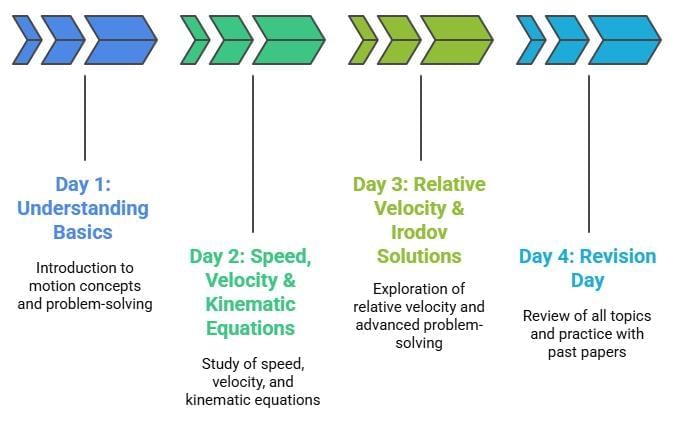4 Days Study Plan: Motion in a Straight Line | Physics Class 11 - NEET PDF Download
| Table of contents |

|
| Day 1: Understanding Basics |

|
| Day 2: Speed and Velocity and Kinematic Equations |

|
| Day 3: Relative Velocity and Irodov Solutions |

|
| Day 4: Revision Day |

|
Let's explore the Class 11 Physics chapter called "Motion in a Straight Line" and how it's important for the NEET Exam. By studying the past years NEET questions (from 2016 to 2025), we can see that this chapter is really important in the exam. If you want to score well in NEET, you need to understand the ideas in this chapter.
Chapter Overview
This chapter covers various fundamental concepts related to motion in a straight line. The key topics include:
- Introduction: Motion in a Straight Line
- Irodov Solutions: Kinematics
- Position vs Path Length vs Displacement
- Average vs Instantaneous Speed & Velocity
- Kinematic Equations: Uniformly Accelerated Motion
- Relative Velocity
Now, let's dive into a well-structured 3-day study plan with an additional day for revision to help you master this chapter.
 4 - Day Study Plan: Motion in a Straight Line
4 - Day Study Plan: Motion in a Straight Line
Day 1: Understanding Basics
Introduction: Motion in a Straight Line
- Start by reading the corresponding chapter in your NCERT textbook.
- Take notes on the key concepts such as types of motion and reference point.
- Solve a few simple numerical problems from the NCERT textbook.
- Explore the Mindmap for a visual overview of the chapter.
Position vs Path Length vs Displacement
- Understand the differences between these terms.
- Solve practice problems to clarify your understanding.
- Refer to the NCERT Solutions for additional clarity.
Day 2: Speed and Velocity and Kinematic Equations
Average vs Instantaneous Speed & Velocity
- Study the concepts of average speed, average velocity, instantaneous speed, and instantaneous velocity.
- Practice numerical problems related to these concepts.
- Check out the Short & Long Answer Question document for more practice questions.
Kinematic Equations: Uniformly Accelerated Motion
- Understand the kinematic equations for uniformly accelerated motion.
- Practice solving problems involving these equations.
- Use the PPT on Motion in a Straight Line for visual aids.
Day 3: Relative Velocity and Irodov Solutions
Relative Velocity
- Study the concept of relative velocity in detail.
- Solve problems related to relative motion.
- Consult your NCERT textbook for additional exercises.
Irodov Solutions: Kinematics
- If you have access to Irodov's book, go through the solutions related to kinematics.
- Try solving some problems from Irodov for additional practice.
Day 4: Revision Day
On this day, review all the topics you've covered in the past three days.
- Revisit your notes and formulae for each topic.
- Solve a mix of questions from previous years' NEET papers using the NEET Previous Year Questions (2016-2025) document.
- Utilize the Mindmap to quickly revise key concepts.
Remember to read from your NCERT textbook and attempt questions from it. For additional support, you can refer to EduRev's Physics Class 11 Course as it provides NCERT-based notes and solutions to NCERT questions.
To aid your memory for important topics, consider creating flashcards or summary sheets. This will help you retain key concepts more effectively.
By following this study plan and incorporating EduRev resources for practice, you'll be well-prepared to tackle the "Motion in a Straight Line" chapter and excel in your NEET exam. Good luck with your studies!
Important Links:
|
96 videos|367 docs|98 tests
|
FAQs on 4 Days Study Plan: Motion in a Straight Line - Physics Class 11 - NEET
| 1. What is the difference between speed and velocity in motion? |  |
| 2. How can I calculate the average speed of an object in motion? |  |
| 3. What is relative velocity and how is it applied in problems? |  |
| 4. How do I approach solving Irodov problems related to motion in a straight line? |  |
| 5. What are some common mistakes to avoid while studying motion in a straight line for NEET? |  |
















